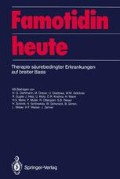Zusammenfassung
Der H2-Rezeptorantagonist Famotidin unterdrückt auf molarer Basis ca. 6- bis 8fach stärker als Ranitidin und ca. 20- bis 40fach stärker als Cimetidin die intragastrale Säuresekretion beim Menschen. Seine Wirksamkeit in der Akut- und Langzeitbehandlung der peptischen Ulcuserkrankung ist durch zahlreiche international durchgeführte Studien gut dokumentiert. Aufgrund seiner ausgeprägten säurehemmenden Eigenschaft gilt Famotidin derzeit als ein H2-Blocker der Wahl bei gastralen Hyperaziditätszuständen.
Access this chapter
Tax calculation will be finalised at checkout
Purchases are for personal use only
Preview
Unable to display preview. Download preview PDF.
Literatur
Ryan R J, Vargas R, Mcmahon, F G, Chremos, A N (1986): Comparison of effects of oral and intravenous famotidine on inhibition of nocturnal gastric acid secretion. Amer J Med 81 [Suppl 4B]: 60 - 64
Bunney R, Wickerson, C R, Forrest, J A H et al (1987): Raising gastric pH: A comparison of intermittent boluses and constant infusions of famotidine. Ital J Gastroent 19, [Suppl Juno No 3]: 43
Merki H, Witzel, L, Langman, M et al (1987): Continous infusion of famotidine maintains high gastric pH in gastric duodenal ulcer. Gastroenterology 92: 1531
Richter W, Angerer M, Hamacher T, Londong W (1987): Dose-response study of famotidine i v on nocturnal intragastric pH in man Ital J Gastroent 19, [Suppl June No 3]: 41
Friedl W, Krier C, Dammann H G et al. (1985): I.v. Famotidin versus i v Ranitidin: Intragastrales pH-Verhalten bei chirurgischen Intensivpatienten. Z Gastroenterologie 23/11: 603 - 607
Naumann C P, Listyosuputro R, Casty E, Gremli Ch (1986): Streßulcer prevention in critically patients: Famotidine versus Ranitidine. Dig Dis Sei 31: 166
Adelt D (1988): Streßulcusprophylaxe in der neurochirurgischen Intensivtherapie (persönliche Mitteilung)
Kuhn P (1987): Prophylaxe von Streßulcusblutungen und Behandlung von Blutungen des oberen Gastrointestinaltrakts. Ergebnisse einer offen durchgeführten, prospektiven Studie mit Famotidin i v Therapiewoche Schweiz 3: 165 - 168
Aoki T (1987): Clinical benefits of intravenously administered famotidine in the tratment of upper gastrointestinal hemorrhage caused by peptic ulcer an stress ulcer disease. Scand J Gastroenterol 22 [Suppl. 134]: 41 - 45
Miyoshi A, Saketa T, Fukutomi H et al (1983): Hemostatic effect of famotidine on upper gastrointestinal hemorrhage. Med Consult Nes Re- med 20/10: 2123 - 2132
Kidokoro T, Nagao F, Mito M et al (1983): Clinical study of famotidine on upper gastrointestinal hemorrhage. Jap Pharmacol Ther II/9: 3659
Kidokoro T, Nagao F, Mito M et al (1984): Clinical study of famotidine on upper gastrointestinal hemorrhage: Doubleblind comparison with Cimetidine. Jap Pharamcol Ther 12/1: 333
Takemura H, Tsuchiya S, Sugiyama M (1986): Therapy and prophylaxis of acute stress ulceration using an H2-receptor antagonist. Dig Dis Sci 31/ 10:1965
Simon B, Bianchi-Porro G, Dammann H G (1986): (Hrsg.) Famotidin: Ein Fortschritt in der Therapie säurebedingter Erkrankungen. Thieme, Stuttgart New York
Müller P, Simon B, Dammann H G, Kommereil B (1987): Ulcus pepticum und H2-Blocker. De Gruyter, Berlin New York
Rights and permissions
Copyright information
© 1989 Springer-Verlag Berlin Heidelberg
About this paper
Cite this paper
Simon, B., Müller, P., Dammann, HG. (1989). Säuresekretionshemmung und Streßulcusprophylaxe von Famotidin i.v.. In: Famotidin heute. Springer, Berlin, Heidelberg. https://doi.org/10.1007/978-3-642-73807-4_7
Download citation
DOI: https://doi.org/10.1007/978-3-642-73807-4_7
Publisher Name: Springer, Berlin, Heidelberg
Print ISBN: 978-3-642-73808-1
Online ISBN: 978-3-642-73807-4
eBook Packages: Springer Book Archive

